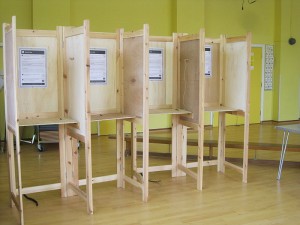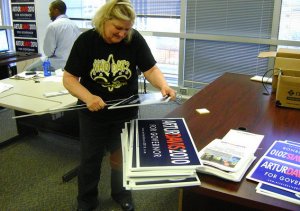Canvassing is both one of the most time-consuming parts of a campaign and one of the most effective ways of reaching voters on a personal level.
And the good, old-fashioned walk book is still one of the most useful tools for effective canvassing.
Except, the it isn't all that old-fashioned anymore. It's gone through quite a transformation in the 21st century, even though its ability to quickly and helpfully guide volunteers and campaign workers through neighborhoods to talk with potential voters, or leave literature when no one's home, remains the same.
It's the equipment available — whether paper or a downloadable app — and the technology behind the "books" that have changed the most. Understanding how they differ and the essentials they should have in common will make all the difference in your canvassing efforts.
In this blog, we'll give an overview of those differences (paper vs. apps), the similarities (technology and data), and we'll talk a bit about how you can best assemble and prepare your canvassing staff – whether volunteers or paid canvassers — because the importance of live contact cannot be underestimated.
We'll discuss those three points in more depth in separate blogs to follow. But for now, here's a quick guide:
Point No. 1: Choose Your Type of Book
Today, there are two main types: the paper version of yore and the new electronic edition, which makes use of an app downloaded onto a tablet or smartphone.
For some campaigns, especially smaller ones, pen and paper may work best for your volunteers — you will never need to worry about the battery life, and you needn't worry about the cost of acquiring tablets and smartphones for campaign workers or volunteers without them.
But for other campaigns, gone are the days when volunteers had to carry around a paper walk book and pen. Today, there is an app for mapping neighborhoods and recording voters' responses, and a good app is well worth any associated costs.
Walk book applications on smart phones or tablets lead to quicker routes in neighborhoods and can speedily pull up data about the residents, information that is up-to-date, geo-coded and defined by household. Volunteers can also easily enter data that they gather while canvassing, giving campaigns information almost instantaneously. According to an article on U.S.News.com, these 21st century walk books give campaigns real-time data, which can help them make decisions quickly.
So what does every good walk book — whether paper or digital — need? This leads to point two:
Point 2: Use Good, Technology-Driven Data
Whether paper or digital, each campaign must make sure that the data they use is current, and the addresses are correct and geo-coded so that your volunteers can find the best and most direct walking routes.
You'd be wise to concentrate on addresses of those voters known to be sympathetic to – or registered with — your party or your campaign's issues, or are known independent voters. Don't waste your time on those solidly opposed to your candidate and campaign.
With redistricting tied up for years in the courts, you also want to make absolutely sure you're targeting within your district. You might think you know this, but it's always good to check (only 43 of 50 states had final congressional redistricting plans approved going into this year's midterms).
Knowing what demographics your campaign needs to reach is further information to have in your walk book. If your campaign needs young, female votes, your canvassers can specifically target houses with young, female residents.
Walk book apps also have the capability to tailor your volunteer's script depending on what answers they receive on questions they ask door to door, so that the conversation is pertinent and on target.
That leads right into our third and final point: How do you get the people able to have these conversations?
Point 3: Create an Effective and Energized Canvassing Team
This is the most important part of any canvassing campaign. Once you've got the nuts and bolts, how do you put it all into operation?
It takes a lot of manpower (and woman power) to knock on 5,500 doors, with current estimates being that 10 people can work 200 doors an hour.
We'll go into best techniques for attracting volunteers and recruiting paid canvassers later. But a tip: pizza parties help raise spirits, and encouraging volunteers to recruit friends is a tried-and-true approach.
But the best, perhaps, is education: Explain your app or book and its features to your volunteers, psyche them to your campaign or cause, and then, appropriately dressed and equipped, let them lose. If they feel like they're spending their time wisely, they'll do so.
If you’re interested in walk books for your political campaign or issue effort, please contact a Campaign Now voter contact specialist today by calling (855) 329-4327 or email info@campaignnowonline.com.





